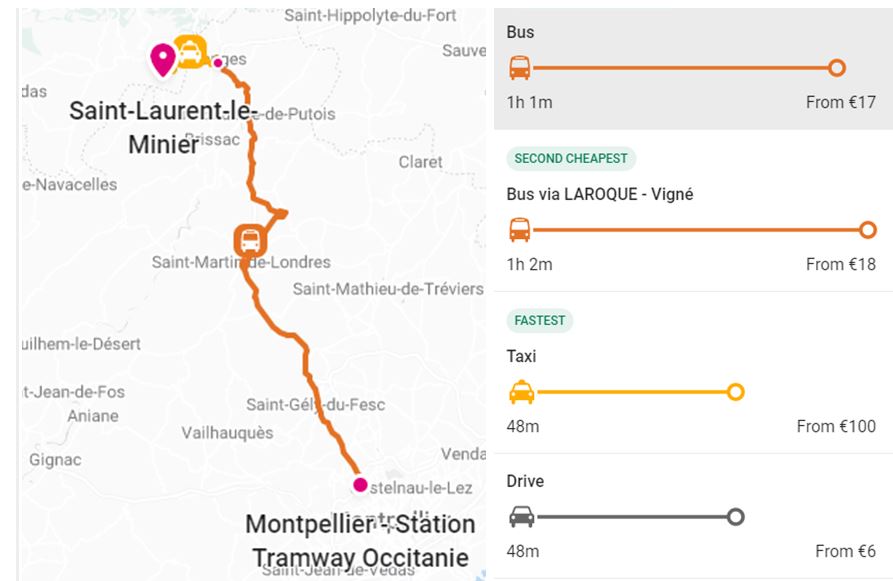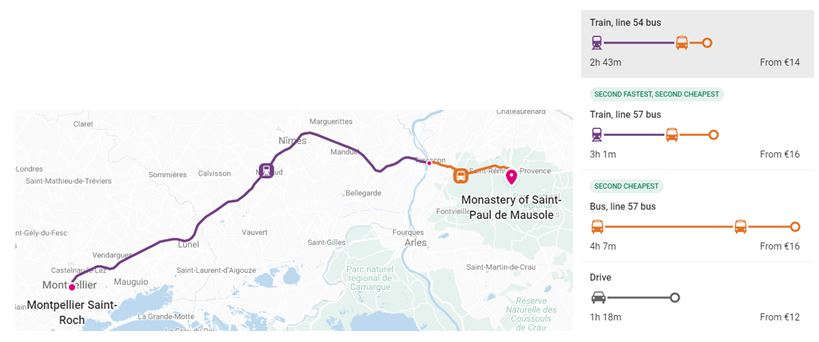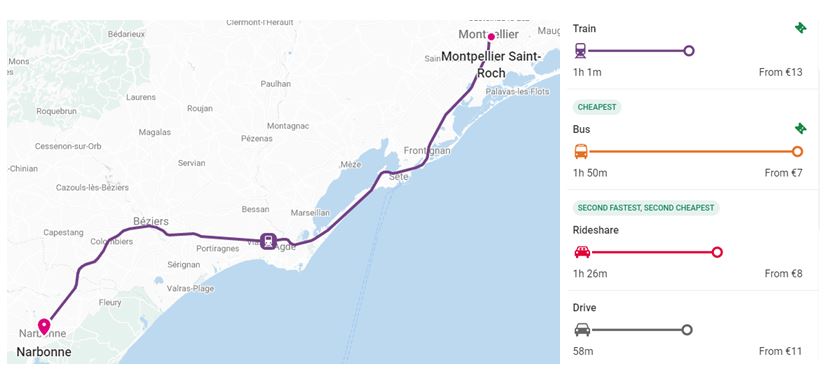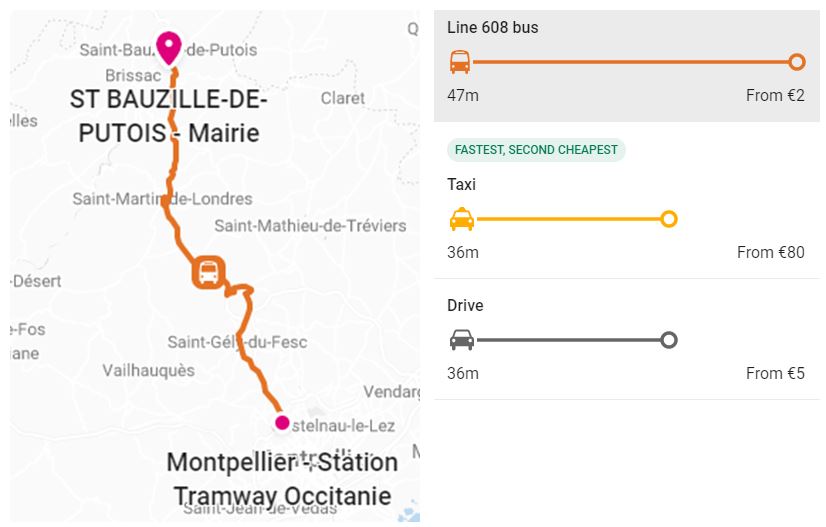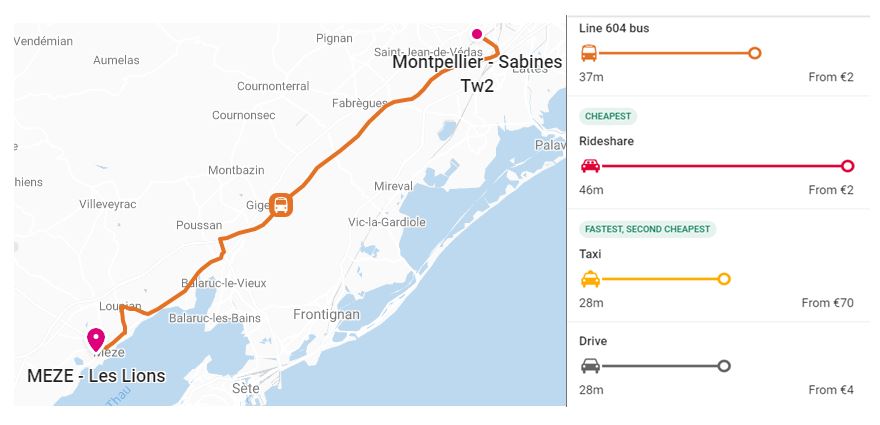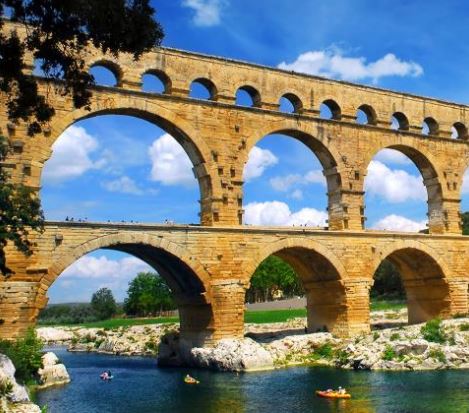
Here are some day trips recommended when staying in Montpellier.
Many of these location suggestions are from the Facebook group Montpellier Internationals
Pont du Gard
Key Feature – Roman aqueduct
The Pont du Gard is the centerpiece of an aqueduct designed to supply running water to the city of Nemausus (Nimes). Its extraordinary dimensions—50 meters high, 490 meters wide (originally)—and its excellent state of preservation make it one of the most valuable relics of Antiquity. Recognized as a masterpiece of human creative genius, it has been a World Heritage site since 1985.
Source: https://visitworldheritage.com/en/eu/pont-du-gard-france/ee1617fd-7ad4-456c-aa68-3465f40834c3
Nimes
Key Feature- Roman Monuments
Nîmes, a city in the Occitanie region of southern France, was an important outpost of the Roman Empire. It’s known for well-preserved Roman monuments such as the Arena of Nîmes, a double-tiered circa-70 A.D. amphitheater still in use for concerts and bullfights. Both the Pont du Gard tri-level aqueduct and the Maison Carrée white limestone Roman temple are around 2,000 years old.
Info: https://about-france.com/cities/nimes.htm
Saint Guillem le désert
Key Feature- Medieval village
In the heart of the Hérault Gorges, in the Val de Gellone, the medieval village of Saint-Guilhem-le-Désert is in a green setting along the meandering Verdus stream.
Its houses are snuggled tightly together in ancient alleyways, with roof tiles baked by the Languedoc sun for twelve centuries. See traces of the past in their arcatures, their lintels, their gemelled windows…Built around the Abbey of Gellone, the village has kept its impressive medieval imprint and constitutes a rare, harmonious site in Languedoc.
This Classified Site, is one of the most beautiful villages in France and today its abbey is registered as a World Heritage Site by UNESCO in conjunction with the french section of St James’ Way to Santiago de Compostela in western Spain.
Source: https://www.saintguilhem-valleeherault.fr/en/saint-guilhem-le-desert-jewel-of-romanesque-art
Aigues-Mortes
Key Feature- Old fortified city
An old fortified city, Aigues-Mortes, in the Gard, represents a prestigious heritage right in the midst of marshlands, in one of the most beautiful spots of Provence, the Camargue. A rough diamond in a jewelry box of uncut gems that time has gradually polished to reveal the magnificence of their sparkle.
Established to the west of the Little Rhône, the medieval city had originally been a small hamlet of fishermen and salt gatherers, washed by marshes reaching to the Mediterranean Sea, in an almost malarial climate. History encircled the town with 1640 m² quadrilateral city walls, comprising six prestigious towers, including the famous Constance Tower, and ten gates, thus housing an astounding religious heritage.
A city marked by the crusades and the Templar Knights, it is today a tourist site where you can make a pleasant excursion into its past, its bullfighting culture, its gastronomy, its wine, and its environment.
Source: https://www.avignon-et-provence.com/en/tourism-provence/aigues-mortes
Arles
Key Feature – Roman monuments
Arles is a good example of the adaptation of an ancient city to medieval European civilization. It has some impressive Roman monuments, of which the earliest – the arena, the Roman theatre, and the cryptoporticus (subterranean galleries) – date back to the 1st century B.C. During the 4th century, Arles experienced a second golden age, as attested by the baths of Constantine and the necropolis of Alyscamps. In the 11th and 12th centuries, Arles once again became one of the most attractive cities in the Mediterranean. Within the city walls, Saint-Trophime, with its cloister, is one of Provence’s major Romanesque monuments.
Source: https://whc.unesco.org/en/list/164/
Cascade de la Vis and the village of Saint Laurent-du-Minier
Key Feature- Large waterfall
Cévennes village located at the outlet of the Gorges de la Vis, whose old bridge offers a view of the Cascade de la Vis.
The town is located on a territory marked by the Vis and its tributaries, the Braun, the Maudesse stream, the Crenze, and the Naduel. These last two cross the village. The Vis forms a large waterfall, the site of which has been inscribed. A 15th and 16th century stone bridge spans the river immediately below the waterfall. A canal bridge, on the left bank, supplies the gardens of the Château de Saint-Laurent-Le-Minier. This one, mostly from the 17th century and partially inscribed, completes the site embedded at the bottom of the gorge. A palm grove has developed on the left bank of the Vis, at the foot of the French gardens of the castle.
Cathédrale de Maguelone
Key Feature- Cathedral
Situated southwest of Montpellier, Villeneuve-lès-Maguelone is blessed with a pristine 9-kilometer long beach, free of any buildings.
You reach it via a footbridge that crosses the Canal du Rhône in Sète. You can travel to the beach on foot, by bicycle or on the little train (from May to September), but there’s more…
In a leafy setting in the center of the peninsula, the Saint-Pierre de Maguelone cathedral is a unique place where history meets tradition.
This fortified church, a former Romanesque bishop’s palace, received popes and bishops in the Middle Ages.
The town has a number of renowned wineries offering a range of wines and muscats that regularly win awards.
Source:: https://www.montpellier-france.com/offre/fiche/cathedrale-saint-pierre-de-maguelone/PCULAR034V500752
St. Remy de Provence
Key Feature- Ancient streets
Situated in the heart of the Alpilles, Saint Remy is one of the “must-sees” in Provence. Surrounded by lush green perfumed valleys, its ancient streets are lined with beautifully restored old houses… you will soon be seduced by Saint Remy’s charm!
While strolling through the narrow winding streets you will discover fantastic old fountains, shady squares, picturesque restaurants, and elegant boutiques.
Source: https://www.provenceweb.fr/e/bouches/stremy/stremy.htm?r=1&Largeur=1600&Hauteur=900
Monastery Saint-Paul de Mausole
Key Feature – Monastery & Van Gogh
Veritable masterpiece of Provençal Romanesque art, the Saint Paul monastery, built in the neighborhood of the Gallo-Roman site of Glanum owes its name Mausolé to the proximity of the mausoleum of the “Julii”; it rises up out of the landscape thanks to its beautiful two-story square steeple topped by a pyramidal roof. The covered walk goes around a finely maintained garden giving the stones all their grandeur.
Saint Paul de Mausole remains today a psychiatric health institution.
The tour of the parts open to the public is subject to the respect of the tranquility of the place. In the former chapter houses and the Romanesque stairwell, you can see a permanent exhibition of works for sale, made by the patients at the art therapy studio Valetudo.
From the top of the stairs, you can see the wheat field that Vincent Van Gogh contemplated and painted during his year of confinement in the men’s pavilion. Upstairs, a room recounts the history of the Saint Paul Mental Hospital. Continuing to the right, you will find a reproduction of the room where Van Gogh was confined. Across from it, another room explains psychiatry in the 19th century.
Source: https://www.avignon-et-provence.com/en/monuments/saint-paul-de-mausole-monastery
Narbonne
Key Feature: Narbonne Plage beach, Canal de la Robine & Gothic Cathédrale St-Just et St-Pasteur
Narbonne is a town in southern France on the Canal de la Robine. The Gothic Cathédrale Saint-Just et Saint-Pasteur was begun in the 13th century but never completed. The Grand Palais des Archevêques (Archbishop’s Palace) houses archeology and art museums. The Horreum is an underground labyrinth of ancient warehouses leftover from the town’s days as a Roman port. The nearby beach and harbor are at Narbonne Plage.
Village of Saint Bauzille de Putois
Key Features: Great views
From the suspension bridge of Saint-Bauzille, the Séranne offers us the perspective of its chain which extends to the west, behind Saint-Micisse, while, on the other side, the steep cliffs of the first foothills of the Cévennes stand out, with, in figurehead, the rock of Thaurac, the cradle of the Grotte des Demoiselles.
Upstream from the village, our eyes are drawn to the majestic and wild beauty of the Gorges of the Haute Vallée de l’Hérault, along which the road and the river meander parallel to each other, tucked in between the sheer cliffs.
Source: https://saintbauzilledeputois.fr/
Sommières
Key Features: Medieval streets
Today, a charming village, Sommières has kept from its past magnificent medieval streets, an attractive Saturday morning market and many traders in its historic part.
Throughout its history, Sommières has remained a prosperous industrial city, working in textiles (a sheet once bore the name of Sommières) and famous for its aromatic essences.
In addition, the famous Terre de Sommières (in fact mined in the small neighboring village of Salinelles) has remained very popular (its “detaching” qualities are no longer to be proven).
Source: https://sommieres.fr/la.ville-36100-1-1-1.php
Uzes
Key Features-
Uzès is the South of France without the beach or bling, a hidden town preserved in white stone. We find a refreshingly laid-back spot with arty places to stay. Make sure that you are in Uzès on a market day. On Wednesdays and Saturdays, the Place aux Herbes is a tight maze of stalls selling all manner of bread, sausage, fish, hunting knives, olives, flowers and leather purses. The medieval garden, a modern recreation situated in the walled precincts of a 12th-century ruin.
Source: https://www.cntraveller.com/gallery/uzes-south-france
Meze
Key Feature: Seaport town
An important port since Phoenician times, Mèze has always primarily been a fishing town. During the Roman Empire, the town lay on the main Southern route from Italy to Spain – the ‘Via Domitia‘. The Romans brought wine to the area and left a legacy of architecture including two of the town’s churches. The production of shellfish, especially oysters, has been the mainstay of the Mèze economy for almost a century and the whole Bassin de Thau area has built an international reputation for the quality of its seafood.
Source: https://en.wikipedia.org/wiki/Meze
Map and costs from Rome2Rio.com






